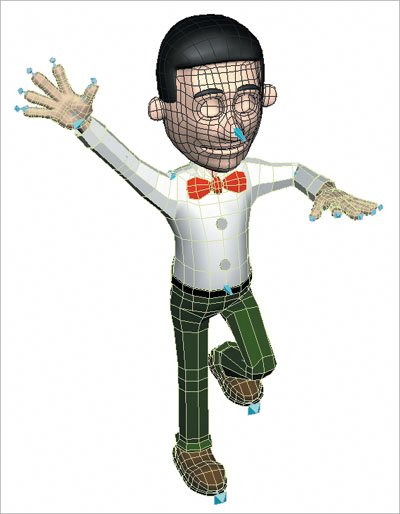Chapter Three. Rigging Characters
Three Rigging Characters

Once your character is modeled, you'll need to get it ready for animation. This process is called rigging. The goal of rigging is to add a skeleton and controls to your model so that an animator can manipulate and animate the character. A properly built skeleton can be quickly and easily manipulated to attain any pose. Once the skeleton is built, it can deform the character in a way that will, ideally, make the rendered character look alive to the audience.
A good character rigger is part animator, part programmer, and part interface designer. The rigger needs to understand how animators work and translate that into an efficient setup. The perfect setup allows animators to have as much control over the character as they need while automatically managing the parts of a character that animators don't have to think about.

Hierarchies and Character Animation |
Chapter One. Basics of Character Design
- Chapter One. Basics of Character Design
- Approaching Design as an Artist
- Design Styles
- Designing a Character
- Finalizing Your Design
Chapter Two. Modeling Characters
Chapter Three. Rigging Characters
- Chapter Three. Rigging Characters
- Hierarchies and Character Animation
- Facial Rigging
- Mesh Deformation
- Refining Rigs
- Conclusion
Chapter Four. Basics of Animation
- Chapter Four. Basics of Animation
- Understanding Motion
- Animation Interfaces
- The Language of Movement
- Secondary Action
- Conclusion
Chapter Five. Creating Strong Poses
- Chapter Five. Creating Strong Poses
- Posing the Body Naturally
- Creating Appealing Poses
- Animating with Poses
- Conclusion
Chapter Six. Walking and Locomotion
- Chapter Six. Walking and Locomotion
- The Mechanics of Walking
- Animating Walks
- Beyond Walking
- Adding Personality to a Walk
- Transitions
- Conclusion
Chapter Seven. Facial and Dialogue Animation
Chapter Eight. Animal Motion
Chapter Nine. Acting
- Chapter Nine. Acting
- Acting Vs. Animating
- Acting and Story
- Acting Technique
- Acting and the Body
- Other Techniques
- Conclusion
Chapter Ten. Directing and Filmmaking
EAN: 2147483647
Pages: 84
